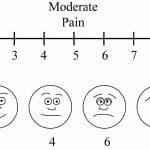Pelvic pain occurs mostly in the lower abdomen area. The pain might be steady, or it might come and go. It can be a sharp and stabbing pain in a specific spot or a dull pain spread out. If the pain is severe, it might get in the way of your daily activities.

In females, it can be a sign of a problem with one of the pelvic area’s organs (uterus, ovaries, fallopian tubes, cervix, or vagina). If you’re a man, it could be due to the prostate. In men and women, it could be a symptom of infection, or a problem with the urinary tract, lower intestines, rectum, muscle, or bone. Some women may have more than one cause.
It is very important for you to learn how bad (severe) your symptoms are.
How bad is my pelvic pain?
Your clinic team will use this scale (see figure on right) to measure how bad your pain is.
Mild: Pain score of 3 or less on the VAS scale. This pain should not stop you from doing activities of daily life (like grocery shopping, laundry, cooking).

Moderate: Pain score of 4 to 6. This pain stops you from doing instrumental activities of daily life (preparing meals, managing money, shopping, doing housework, and using a telephone).
Severe: Pain score of 7 or higher. This pain is bad enough to stop you from even the most basic (self-care) activities of daily life like eating, dressing, getting into or out of a bed or chair, taking a bath or shower, and using the toilet.
Warning signs/severe symptoms of pelvic pain that need immediate medical attention
Make an appointment with your doctor if pelvic pain disrupts your daily life or if your symptoms seem to be getting worse. Your doctor will suggest the treatment as per your causes and symptoms.
Keep track of your pain levels using Ankr (myAnkr web portal or the Ankr app). It will help you describe the pain to your doctor or nurse.
Supportive care for Pelvic pain
- Over-the-counter (OTC) nonsteroidal anti-inflammatory drugs (NSAIDs) ibuprofen or naproxen
- OTC laxatives, exercise, and increase in fiber and fluid consumption for constipation
- Relaxation exercises, which can include yoga and meditation
- Heating pads or hot water bottles. If you suspect an infection like appendicitis, do not apply heat
What caused my pelvic pain?
- Appendicitis
- Bladder disorders
- Colon cancer and surgeries
- Sexually transmitted diseases
- Kidney infection or kidney stones
- Intestinal disorders
- Nerve conditions
- Hernia
- Pelvis disorder
- Prostatitis
- Testicular disorders
- Broken pelvis
- Psychogenic pain
- Ectopic pregnancy
- Miscarriage
- Pelvic inflammatory disease
- Menstrual cramps
- Ovarian cysts or other ovarian disorders
- Fibroids
- Endometriosis
- Uterine Cancer
- Cervical cancer
